Related Research Articles

A drink or beverage is a liquid intended for human consumption. In addition to their basic function of satisfying thirst, drinks play important roles in human culture. Common types of drinks include plain drinking water, milk, juice, smoothies and soft drinks. Traditionally warm beverages include coffee, tea, and hot chocolate. Caffeinated drinks that contain the stimulant caffeine have a long history.
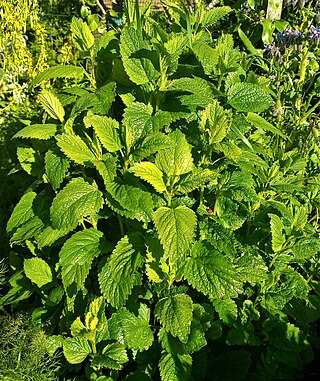
Lemon balm is a perennial herbaceous plant in the mint family and native to south-central Europe, the Mediterranean Basin, Iran, and Central Asia, but now naturalised elsewhere.

Sweet tea, also known as sweet iced tea, is a popular style of iced tea commonly consumed in countries such as the United States and Indonesia. Sweet tea is most commonly made by adding sugar or simple syrup to black tea either while the tea is brewing or still hot, although artificial sweeteners are also frequently used. Sweet tea is almost always served ice cold. It may sometimes be flavored, most commonly with lemon but also with peach, raspberry, or mint. The drink is sometimes tempered with baking soda to reduce its acidity. Although sweet tea may be brewed with a lower sugar and calorie content than most fruit juices and sodas, it is not unusual to find sweet tea with a sugar level as high as 22 degrees Brix, or 22 g per 100 g of liquid, a level twice that of Coca-Cola.

Tea is an aromatic beverage prepared by pouring hot or boiling water over cured or fresh leaves of Camellia sinensis, an evergreen shrub native to East Asia which probably originated in the borderlands of southwestern China and northern Myanmar. Tea is also rarely made from the leaves of Camellia taliensis. After plain water, tea is the most widely consumed drink in the world. There are many different types of tea; some have a cooling, slightly bitter, and astringent flavour, while others have vastly different profiles that include sweet, nutty, floral, or grassy notes. Tea has a stimulating effect in humans primarily due to its caffeine content.
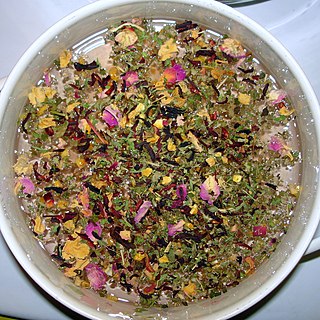
Herbal teas, also known as herbal infusions and less commonly called tisanes, are beverages made from the infusion or decoction of herbs, spices, or other plant material in hot water. Oftentimes herb tea, or the plain term tea, is used as a reference to all sorts of herbal teas. Many herbs are used in herbal medicine. Some herbal blends contain actual tea.

A teaspoon (tsp.) is an item of cutlery. It is a small spoon that can be used to stir a cup of tea or coffee, or as a tool for measuring volume. The size of teaspoons ranges from about 2.5 to 7.3 mL. For cooking purposes and dosing of medicine, a teaspoonful is defined as 5 mL, and standard measuring spoons are used.

Momordica charantia is a tropical and subtropical vine of the family Cucurbitaceae, widely grown in Asia, Africa, and the Caribbean for its edible fruit. Its many varieties differ substantially in the shape and bitterness of the fruit.

Yuzu is a citrus fruit and plant in the family Rutaceae of East Asian origin. Yuzu has been cultivated mainly in East Asia, though recently also in New Zealand, Australia, Spain, Italy, and France.

Jomolhari or Chomolhari sometimes known as "the bride of Kangchenjunga”, is a mountain in the Himalayas, straddling the border between Yadong County of Tibet, China and the Paro district of Bhutan. The north face rises over 2,700 metres (8,900 ft) above the barren plains. The mountain is the source of the Paro Chu which flows from the south side and the Amo Chu which flows from the north side.

Cinnamomum tamala, Indian bay leaf, also known as tejpat, tejapatta,Malabar leaf, Indian bark, Indian cassia, or malabathrum, is a tree in the family Lauraceae that is native to India, Bangladesh, Nepal, Bhutan, and China. It can grow up to 20 m (66 ft) tall. Its leaves have a clove-like aroma with a hint of peppery taste; they are used for culinary and medicinal purposes. It is thought to have been one of the major sources of the medicinal plant leaves known in classic and medieval times as malabathrum.
Natural skin care uses topical creams and lotions made of ingredients available in nature. Much of the recent literature reviews plant-derived ingredients, which may include herbs, roots, flowers and essential oils, but natural substances in skin care products include animal-derived products such as beeswax, and minerals. These substances may be combined with various carrier agents, preservatives, surfactants, humectants and emulsifiers.

Infusion is the process of extracting chemical compounds or flavors from plant material in a solvent such as water, oil or alcohol, by allowing the material to remain suspended in the solvent over time. An infusion is also the name for the resultant liquid. The process of infusion is distinct from both decoction—a method of extraction involving boiling the plant material—and percolation, in which water is passed through the material.
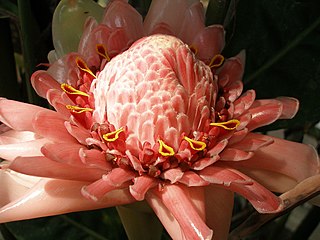
Etlingera elatior is a species of herbaceous perennial plant. Botanical synonyms include Nicolaia elatior, Phaeomeria magnifica, Nicolaia speciosa, Phaeomeria speciosa, Alpinia elatior, and Alpinia magnifica.
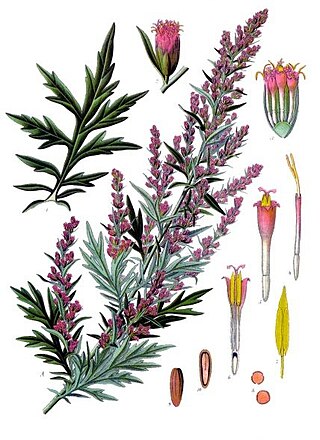
Mugwort is a common name for several species of aromatic flowering plants in the genus Artemisia. In Europe, mugwort most often refers to the species Artemisia vulgaris, or common mugwort. In East Asia the species Artemisia argyi is often called "Chinese mugwort" in the context of traditional Chinese medicine, or àicǎo (艾草) in Mandarin. Artemisia princeps is a mugwort known in Korea as ssuk (쑥) and in Japan as yomogi (ヨモギ). While other species are sometimes referred to by more specific common names, they may be called simply "mugwort" in many contexts.

Gaz is an Iranian nougat that originated in Isfahan region. It is widely known as Persian Nougat in American and European countries. It is made from pistachio, almond kernels, rose-water, egg whites and sap from a special plant.

High-mountain tea or gaoshan tea refers to several varieties of Oolong tea grown in the mountains of central Taiwan. It is grown at altitudes higher than 1,000 metres (3,300 ft) above sea level, and includes varieties such as Alishan, Dayuling, Yu Shan, Wushe, and Lishan. The high humidity and natural precipitation in the high mountain ranges of Nantou and Chiayi Counties make the region a suitable environment for growing tea plants. High Mountain Oolong is a tea that holds all of its original nutrients that are within the unfermented green tea. It does not hold the usual grass-like taste, but the fermentation process that removes the harsh ingredients allows the tea to taste flavorful.

Bhutanese cuisine employs much red rice, buckwheat, and increasingly maize.

Brazilian tea culture has its origins in the infused beverages, or chás, made by the indigenous cultures of the Amazon region and the Rio da Prata basin. It has evolved since the Portuguese colonial period to include imported varieties and tea-drinking customs. There is a popular belief in Brazil that Brazilians, especially the urban ones, have a greater taste for using sugar in teas than in other cultures, being unused to unsweetened drinks.
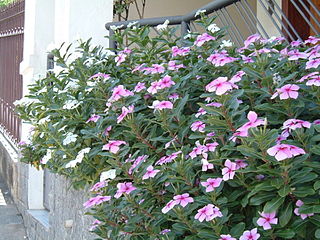
Dominican tea culture combines many customs adapted from various colonial and immigrant cultures that have mingled in Dominica. "Bush teas", made from local herbal plants and often taken for medicinal purposes, are a traditional part of Dominica's culture.

Druk Wangditse Lhakhang("Temple of the Peak of Conquest"),(འབྲུག་དབང་འདུས་རྩེ་ལྷ་ཁང་) is located high on a forested ridge to the south of Tashichho Dzong and overlooks the whole Thimphu valley. It was established in 1715 as the seat of the 8th Druk Desi, Druk Rabgye.
References
- ↑ "Tsheringma : A drink with a difference". RAO online. Retrieved 19 February 2020.